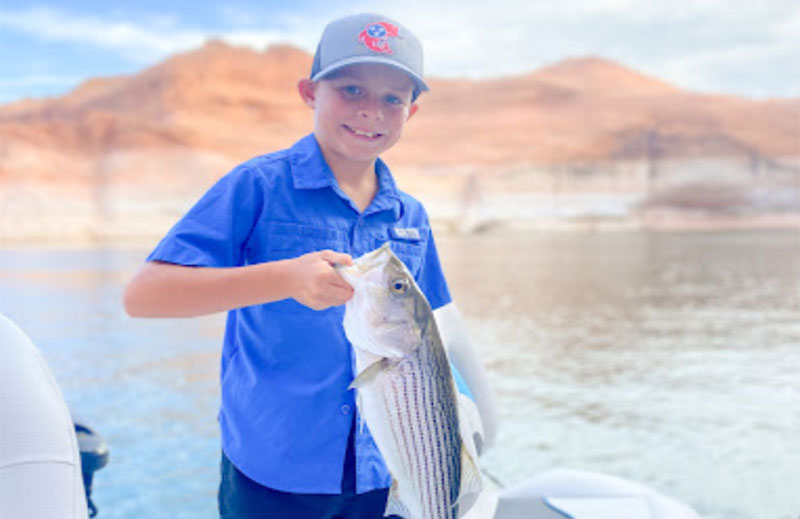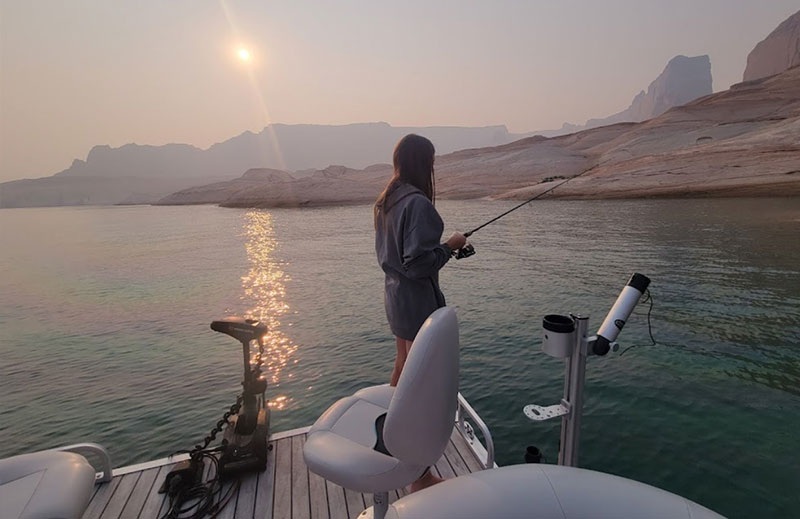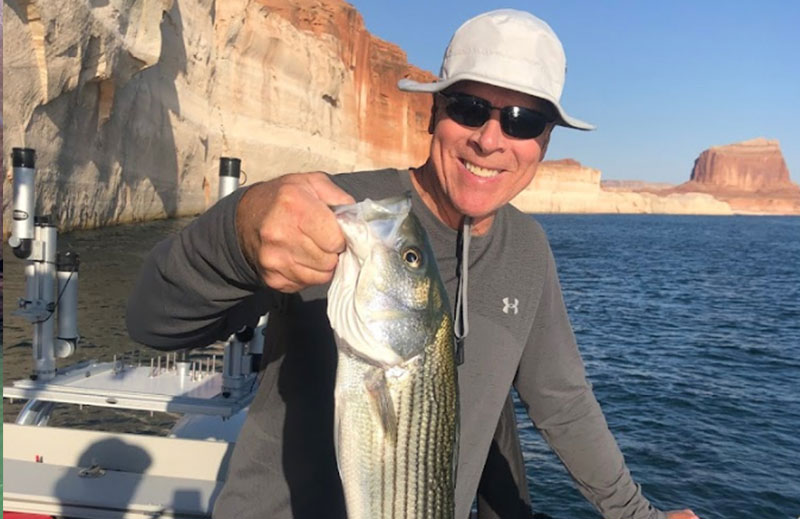Lake Powell is one of the premier fishing destinations in the Southwest, offering more than 2,000 miles of shoreline and a variety of species for anglers of all skill levels. From striped bass to largemouth, smallmouth, walleye, and crappie, the lake supports strong fishing year-round if you know where to look and what techniques to use.
This Lake Powell fishing guide will walk you through the best fishing spots, recommended bait and lures, and how each season affects your chances for success. Whether you’re a local looking for a refresher or a first-time visitor, these Lake Powell fishing tips will help you get the most out of your trip.
Popular Fish Species in Lake Powell
Before we talk about spots and seasons, it’s important to know what you’re targeting. Lake Powell is home to several game fish, each with its own habits and preferred conditions.
- Striped Bass (Stripers): Often schooled in large numbers, excellent for anglers looking for consistent action.
- Largemouth Bass: Found in warmer, shallow waters near vegetation or structure.
- Smallmouth Bass: Common around rocky shorelines, points, and submerged structure.
- Walleye: Active in cooler water, often near sandy points or drop-offs.
- Crappie: Usually found in submerged brush or near structure in spring.
Best Fishing Spots on Lake Powell
While fish can be found across the entire lake, certain areas consistently produce better results. Based on years of guiding experience, here are five of the best fishing spots Lake Powell has to offer.
Wahweap Bay is one of the most convenient and productive spots on the lake, located right near Wahweap Marina. This area offers a mix of rocky points, sandy beaches, and open water, making it a prime location for multiple species. Striped bass schools often move through the bay, especially in summer, and smallmouth bass can be found working along the rocky shorelines. Walleye are also present here, particularly near points and drop-offs.
During the summer months, anglers should keep an eye out for early morning and evening boils — surface-feeding frenzies where stripers are actively chasing baitfish.
Navajo Canyon is another popular fishing location, especially for smallmouth bass, largemouth bass, and crappie. The canyon’s rocky ledges, submerged structure, and calm coves provide excellent habitat for bass year-round. In the spring, crappie fishing is particularly productive around submerged brush. Soft plastics, crankbaits, and jigs are all effective in this area, especially when worked along the rocky banks.
Its proximity to Page, Arizona, makes Navajo Canyon an ideal choice for anglers looking for a quick day trip without spending hours traveling by boat.
Padre Bay stands out for its expansive open water surrounded by dramatic rock formations. It’s a consistent spot for both striped bass and smallmouth bass. Stripers here often suspend in deeper water, making trolling with deep-diving crankbaits or fishing with anchovy rigs an effective approach. Smallmouth bass can be targeted near the rocky points and along the shoreline.
Because of its size, Padre Bay offers plenty of space for anglers to spread out, but keep in mind that afternoon winds can make fishing more challenging in the open water.
The San Juan Arm is a more remote fishing destination but well worth the trip for anglers looking for less-pressured waters. Located far from the main marinas, this area is known for abundant structure, vegetation, and diverse habitat. Largemouth bass thrive in the vegetated coves, and walleye hold near sandy points and drop-offs.
Spinnerbaits and soft plastics work well for largemouth here, while jigging with worms or minnows can produce good walleye catches. The San Juan Arm is best suited for anglers on multi-day trips due to its distance from services.
The Bullfrog and Halls Crossing area is an excellent northern fishing location that offers cooler water temperatures in the summer, which can help keep fish active during the hottest months. The region is known for strong walleye and striped bass action, along with smallmouth bass along the rocky points.
Points and drop-offs hold walleye early in the day, and trolling or vertical jigging with nightcrawlers is often productive. Because of its location, this area also experiences less fishing pressure than the southern end of the lake, making it a great choice for anglers willing to make the trip.
Best Bait and Lures for Lake Powell
Choosing the right bait is just as important as picking the right location. Here are proven options for each main species.
Striped Bass:
- Anchovies (cut bait)
- Spoons (1–2 oz)
- Deep-diving crankbaits
- Swimbaits in shad patterns
Smallmouth Bass:
- Soft plastic grubs or tube
- Crankbaits mimicking crawfish
- Drop shot rigs with worms
Largemouth Bass:
- Spinnerbaits
- Topwater lures in summer mornings
- Jigs with trailers
Walleye:
- Bottom-bouncer rigs with nightcrawlers
- Jigs with minnows or soft plastics
- Small crankbaits along drop-offs
Crappie:
- Small jigs (1/16 oz) with chartreuse or white bodies
- Minnows under slip bobbers
Seasonal Fishing Patterns on Lake Powell
Lake Powell’s seasons have a major influence on fish behavior. Here’s how to approach each time of year.
Spring (March–May)
- Water Temp: Rising into the 50s and 60s.
- Best Species: Largemouth and smallmouth bass move into shallows to spawn. Crappie fishing peaks. Walleye active near points.
Tips: Use slower presentations; mornings can still be cool. Look for bass in 5–15 feet of water near structure.
Summer (June–August)
- Water Temp: Often mid-70s to low-80s.
- Best Species: Striped bass schools active in open water; early morning and late evening boils common.
- Tips: Topwater lures for bass in early morning; switch to deeper presentations mid-day. Stripers respond to trolling and bait fishing.
Fall (September–November)
- Water Temp: Cooling into the 60s.
- Best Species: Bass and walleye feed heavily before winter; stripers school deeper but still bite.
Tips: Crankbaits and spinnerbaits along rocky banks produce well. Look for stripers on sonar in 30–60 feet of water.
Winter (December–February)
- Water Temp: 40s to low-50s.
- Best Species: Striped bass remain catchable deep; walleye fishing possible on warmer days.
Tips: Fish slow and deep. Jigs and spoons work well when fish are sluggish.
Additional Lake Powell Fishing Tips
- Watch the Wind: Afternoon winds are common, especially in open bays. Plan travel and fishing around calmer morning conditions.
- Use Electronics: A good fishfinder helps locate deeper schools of stripers and walleye.
- Vary Depths: If you’re not getting bites, adjust your depth before moving spots.
- Regulations: Always check Utah and Arizona fishing regulations. Lake Powell spans both states, and licenses from either are valid for the entire lake.
- Safety: Wear a life jacket, especially when moving between locations.
Planning Your Trip
If you’re visiting for a day or two, focus on accessible locations near your marina — Wahweap Bay, Navajo Canyon, and Padre Bay are excellent starting points. For longer trips, consider exploring farther destinations like the San Juan Arm or Bullfrog area for less pressure and unique fishing opportunities.
When possible, time your trip around the species you want to target. For example:
- For stripers, summer mornings and fall deep-water fishing are most productive.
- For bass, spring and early summer offer consistent shallow-water action.
- For walleye, late spring and early fall are peak times.
Summary
This Lake Powell fishing guide covers the essential information you need to locate and catch fish on one of the Southwest’s top fishing lakes. From identifying the best fishing spots Lake Powell offers to knowing which bait and techniques work in each season, preparation is the key to a successful trip.
With these Lake Powell fishing tips in mind — and a little time on the water — you’ll be well on your way to enjoying the variety and excitement that Lake Powell fishing provides year-round.




